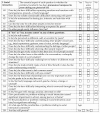The autism--tics, AD/HD and other comorbidities inventory (A-TAC): further validation of a telephone interview for epidemiological research
- PMID: 20055988
- PMCID: PMC2823676
- DOI: 10.1186/1471-244X-10-1
The autism--tics, AD/HD and other comorbidities inventory (A-TAC): further validation of a telephone interview for epidemiological research
Abstract
Background: Reliable, valid, and easy-to-administer instruments to identify possible caseness and to provide proxies for clinical diagnoses are needed in epidemiological research on child and adolescent mental health.The aim of this study is to provide further validity data for a parent telephone interview focused on Autism--Tics, Attention-deficit/hyperactivity disorder (AD/HD), and other Comorbidities (A-TAC), for which reliability and preliminary validation data have been previously reported.
Methods: Parents of 91 children clinically diagnosed at a specialized Child Neuropsychiatric Clinic, 366 control children and 319 children for whom clinical diagnoses had been previously assigned were interviewed by the A-TAC over the phone. Interviewers were blind to clinical information. Different scores from the A-TAC were compared to the diagnostic outcome.
Results: Areas under ROC curves for interview scores as predictors of clinical diagnoses were around 0.95 for most disorders, including autism spectrum disorders (ASDs), attention deficit/hyperactivity disorder (AD/HD), tic disorders, developmental coordination disorders (DCD) and learning disorders, indicating excellent screening properties. Screening cut-off scores with sensitivities above 0.90 (0.95 for ASD and AD/HD) were established for most conditions, as well as cut-off scores to identify proxies to clinical diagnoses with specificities above 0.90 (0.95 for ASD and AD/HD).
Conclusions: The previously reported validity of the A-TAC was supported by this larger replication study using broader scales from the A-TAC-items and a larger number of diagnostic categories. Short versions of algorithms worked as well as larger. Different cut-off levels for screening versus identifying proxies for clinical diagnoses are warranted. Data on the validity for mood problems and oppositional defiant/conduct problems are still lacking. Although the A-TAC is principally intended for epidemiological research and general investigations, the instrument may be useful as a tool to collect information in clinical practice as well.
Figures



Similar articles
-
Predictive properties of the A-TAC inventory when screening for childhood-onset neurodevelopmental problems in a population-based sample.BMC Psychiatry. 2013 Sep 25;13:233. doi: 10.1186/1471-244X-13-233. BMC Psychiatry. 2013. PMID: 24066834 Free PMC article.
-
The Autism--Tics, AD/HD and other Comorbidities (A-TAC) telephone interview: convergence with the Child Behavior Checklist (CBCL).Nord J Psychiatry. 2010 May 4;64(3):218-24. doi: 10.3109/08039480903514443. Nord J Psychiatry. 2010. PMID: 20192892
-
Psychiatric telephone interview with parents for screening of childhood autism - tics, attention-deficit hyperactivity disorder and other comorbidities (A-TAC): preliminary reliability and validity.Br J Psychiatry. 2005 Sep;187:262-7. doi: 10.1192/bjp.187.3.262. Br J Psychiatry. 2005. PMID: 16135864
-
[Diagnostic structured interviews in child and adolescent's psychiatry].Encephale. 2004 Mar-Apr;30(2):122-34. doi: 10.1016/s0013-7006(04)95422-x. Encephale. 2004. PMID: 15107714 Review. French.
-
The relationship between autism spectrum disorders and attention-deficit/hyperactivity disorder: an overview.Res Dev Disabil. 2013 Sep;34(9):2475-84. doi: 10.1016/j.ridd.2013.05.021. Epub 2013 Jun 7. Res Dev Disabil. 2013. PMID: 23751293 Review.
Cited by
-
Associations of impulsivity, hyperactivity, and inattention with nonsuicidal self-injury and suicidal behavior: longitudinal cohort study following children at risk for neurodevelopmental disorders into mid-adolescence.BMC Psychiatry. 2022 Nov 3;22(1):679. doi: 10.1186/s12888-022-04311-5. BMC Psychiatry. 2022. PMID: 36329415 Free PMC article.
-
Subthreshold and threshold attention deficit hyperactivity disorder symptoms in childhood: psychosocial outcomes in adolescence in boys and girls.Acta Psychiatr Scand. 2016 Dec;134(6):533-545. doi: 10.1111/acps.12655. Epub 2016 Oct 7. Acta Psychiatr Scand. 2016. PMID: 27714770 Free PMC article.
-
Effect of co-twin gender on neurodevelopmental symptoms: a twin register study.Mol Autism. 2016 Jan 19;7:8. doi: 10.1186/s13229-016-0074-z. eCollection 2016. Mol Autism. 2016. PMID: 26793297 Free PMC article.
-
The Development and Piloting of an Early Youth-Engagement (EYE) Model to Improve Engagement of Young People in First Episode Psychosis Services: A Mixed Methods Study.Early Interv Psychiatry. 2025 Jan;19(1):e13623. doi: 10.1111/eip.13623. Epub 2024 Oct 22. Early Interv Psychiatry. 2025. PMID: 39435971 Free PMC article.
-
Associations between conduct problems in childhood and adverse outcomes in emerging adulthood: a longitudinal Swedish nationwide twin cohort.J Child Psychol Psychiatry. 2020 Jul;61(7):798-806. doi: 10.1111/jcpp.13169. Epub 2019 Dec 18. J Child Psychol Psychiatry. 2020. PMID: 31849046 Free PMC article.
References
-
- Hansson SL, Svanstrom Rojvall A, Rastam M, Gillberg IC, Gillberg C, Anckarsater H. Psychiatric telephone interview with parents for screening of childhood autism-tics, attention-deficit hyperactivity disorder and other comorbidities (A-TAC): preliminary reliability and validity. Br J Psychiatry. 2005;187(3):262–267. doi: 10.1192/bjp.187.3.262. - DOI - PubMed
-
- Anckarsater H, Larson T, Hansson SL, Carlstrom E, Stahlberg O, Gillberg IC, Rastam M, Gillberg C, Lichtenstein P. Child psychiatric problems are dimensionally distributed and highly inter-correlated in the general population. The Open Psychiatry Journal. 2008;2:5–11. doi: 10.2174/1874354400802010005. - DOI
-
- Gillberg C, Gillberg IC, Rasmussen P, Kadesjo B, Soderstrom H, Rastam M. Co-existing disorders in ADHD - implications for diagnosis and intervention. Eur Child Adolesc Psychiatry. 2004;13(Suppl 1):180–92. - PubMed
Publication types
MeSH terms
LinkOut - more resources
Full Text Sources
Medical

